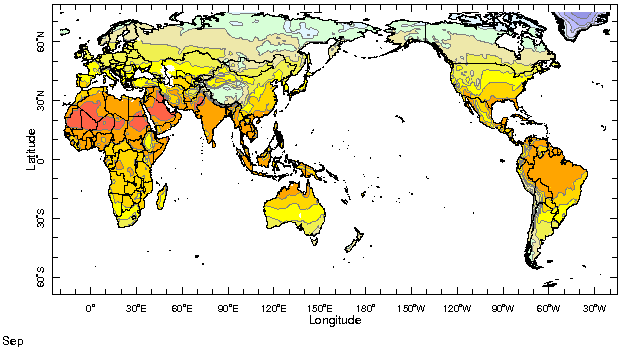|
IRI Climate Digest
October 2004
September Global Climate Summary
Climatological Background
During September, the Northern Hemisphere monsoon systems in West Africa, South Asia, and southwestern North America begin their retreat southward following the maximum solar heating which approaches the equator at the time of the equinox (September 21). Spring has begun in the Southern Hemisphere, with mid-latitude storm tracks losing strength.
Monthly Mean Temperature (1961-1990), data from the Climate Research
Unit, University of East Anglia


Monthly Mean Precipitation (1961-1990), data from the Climate Research
Unit, University of East Anglia


Temperatures
Highlights
The trough-ridge pattern in the northern hemisphere that had largely persisted throughout the boreal summer shifted in September, bringing warmer-than-normal temperatures to much of central and eastern North America and cool conditions to Alaska and much of western Canada. Most of Eurasia experienced near- or above-normal temperatures, as did West Africa and South America. Portionss of Australia and eastern South Africa had below-normal temperatures in September.
Temperature Difference from the 1961-1990 mean, with data
from NCEP Climate Prediction Center, CAMS.


Precipitation
Highlights
During September drier-than-normal conditions predominated in the Philippines and in some areas of Southeast Asia. Tropical cyclone activity brought wet conditions to the east coast of China, Taiwan, and southern Japan. Although some eastern provinces of China experienced below-normal precipitation, much of eastern China experienced wetter-than-normal conditions. At the end of the southwest monsoon season, precipitation was below normal in much of northern and central India, however, Bangladesh, southern India, and Sri Lanka received heavier-than-normal precipitation. Tropical cyclones were responsible for above-normal rainfall totals along the east coast of the U.S., but drier-than-normal conditions further inland extended from eastern Canada to the Gulf of Mexico. Drier-than-normal conditions were also experienced in eastern South America and across much of Europe and the Sahelian region. Above-normal amounts of precipitation were observed in northwestern South America.
Precipitation Difference from 1979-1995 mean, with data
from NCEP Climate Prediction Center, CAMS-OPI.


Oceanic Conditions
Sea surface temperatures remained 1°C above normal over a large part of the central equatorial Pacific again in September, while cooler-than-normal temperatures in the eastern equatorial Pacific moderated compared to the previous month. See the latest IRI ENSO Update for a detailed summary and outlook for the tropical Pacific. Warmer-than-normal temperatures became more widespread in the equatorial and tropical North Atlantic Ocean in September, but weakened in intensity off the coast of northwest Africa and the the Iberian Peninsula. Ocean temperatures off the Horn of Africa in the western Indian Ocean warmed with respect to normal in the September monthly average. In the extratropical North Pacifc, colder-than-normal ocean temperatures developed in the west as above-normal temperatures persisted in the central and eastern parts of the basin. Temperature anomalies in the North Atlantic basin weakened in general in September.
Monthly Sea Surface Temperature Difference from the 1971-2000 mean,
with data from the Environmental Modeling Center, NCEP/NOAA.


Contents |
Special |
Impacts |
Climate |
Forecast
|

